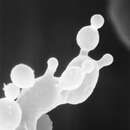en
names in breadcrumbs


Sporangiophores erect, unbranched or branched, bearing fertile hyphae laterally. Fertile hyphae septate, branched subverticellately, bearing many multicelled fertile branches bearing 2-spored merosporangia. Sporangiospores subglobose to ellipsoid; dry at maturity. Zygospores globose, wall thin and ornamented; suspensors hyphoid. Haustorial parasites of Mucorales.
Benjamin (1959) reported thatT. californicuscould be grown on many culture media on numerous mucoralean hosts. He also said thatT. californicuscould be grown onMEYEagar without a host and it would reproduce normally, both sexually and asexually. Sporangiophores of matureT. californicusseparate readily at a zone immediately below the spore-forming region. A second species,T. parasiticus, was isolated from mouse dung collected in Illinois (Benjamin, 1961). (Zygomycetes.org.2015)